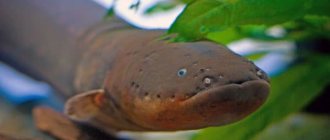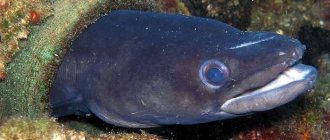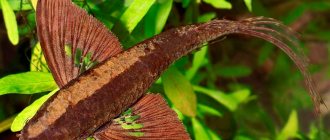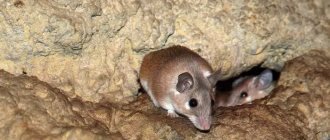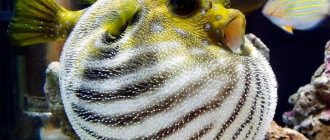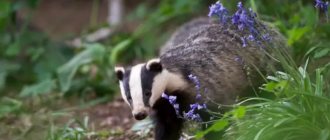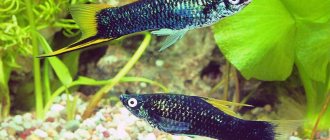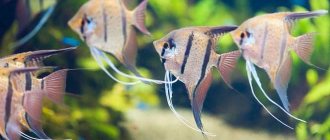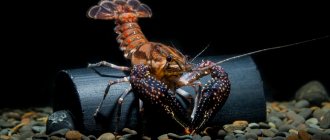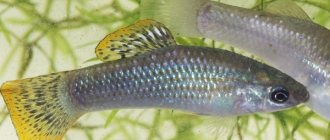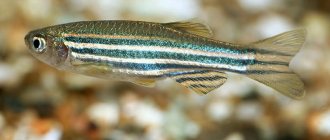4.8
(5)
When an experienced aquarist gets tired of goldfish and cichlids, there is a desire to create something unusual in his underwater world. The eel macrognathus is ideal for such cases. Its unusual body shape and habits can surprise even experienced breeders.
Macrognathus aculeatus
Description and natural habitat
Natural range: Thailand, Cambodia, Burma, India. Fresh and slightly salty reservoirs of Southeast Asia, the Mekong and Chao Phraya rivers with warm waters, dense thickets of algae and a muddy bottom.
The eel has an interesting appearance. The long elongated body reaches about 25 cm in captivity and up to 40 cm in the wild. There are no pectoral fins, and the caudal and dorsal fins are located at the end of the body and have a reddish color. The body of the fish itself is painted in various shades of brown and olive. It has light stripes along its entire length, dark spots and dots, and a lighter belly. There are spines on the back. Macrognathus has a small, pointed head.
Life expectancy, depending on the type and living conditions, ranges from 8 to 18 years.
The lifestyle is predominantly bottom-dwelling. During the day it prefers to hide in thickets, burrow into the ground, at night it swims out and behaves actively, and also hunts. The predatory fish observes its surroundings, remaining motionless for a long time.
Photo gallery of Macrognathus:
Interestingly, in nature Macrognathus can leave a body of water for 1 hour in search of food.
The eel is a spawning species, but in captivity natural reproduction is difficult and stimulation will be required.
Reviews
The aquarium eel has captivated many. The varied behavior of pets is noteworthy. For some aquarists, the eel is mobile and accepts most types of food; for others, macrognathus hides in the ground and eats exclusively live food.
Mr. Tail Recommends: Variety of Species
Representatives of the family are divided into 2 groups: Macrognathus and Mastacembel. The differences between them are minimal, mainly in color and size. The table shows the most popular types of each group.
| Group | Variety | Description and length (cm) |
| Macrognathus | Siamese or ocellated | Beige-brown body color with light transverse stripes. Spotted dorsal fin. It can eat smaller inhabitants of the aquarium. 30. |
| Pearl | The body is brown with a silver tint. 17. | |
| Aral | The body is olive or brown, with a horizontal stripe on the sides. Dark and light brown spots on the fin. 60. | |
| Mastacembel | Coffee | The body is coffee colored with beige spots and vertical lines. Very friendly. 15. |
| Red Striped | The largest species. Black or dark gray striped body with red or yellow lines. The fins have stripes of the same shade. Neighborhood is acceptable with proportionate individuals. 100. | |
| Armatus or armored | The body is light brown with dark spots. Gets along with large individuals. 70-90. | |
| Moore | Exotic view from African Lake Tanganyika. Light brown color of the fish with spots. Neighborhood with large individuals is allowed. 40. |
Adviсe
- Don't turn on the lights suddenly. First, turn on the dim light in the room, and after a few minutes, turn on the aquarium lamp.
- If the eel is outside the aquarium, place it in a container of water separately from other inhabitants. Do not disturb your pet for a while and monitor its condition.
- Frozen food should not be re-frozen.
- Place the aquarium away from sunlight to prevent excessive algae growth.
In addition to the ocellated fish, the Siamese macrognathus fish (Macrognathus siamensis) is popular. According to the description, macrognathus resemble mastacembelas, so they are often confused. Popular among the mastacembels are Moore's mastacembelus moorii, mastacembelus erythrotaenia, and mastacembelus armatus.
Previous
FishBasic components for feeding guppies
Next
FishWhat the corridor itself needs for a comfortable stay
Aquarium Basics
For your pet to have a comfortable life in the aquarium, proper care must be taken. The following conditions must be adhered to:
- tank volume is at least 100 liters;
- water quality and purity are high;
- weekly replacement of about 30% of the fluid volume;
- good aeration and filtration;
- temperature about +21…+27 °C;
- acidity no more than 7 pH;
- hardness below 15 °dH;
- dim light, reminiscent of the natural lighting of Asian bodies of water, must be turned off at night;
- water salinity control;
- the presence of aquarium plants and soft soil;
- It is necessary to have a reliable lid for the aquarium; the eel can crawl out of it.
Safety
The main causes of death of aquarium eels: hunger and skin diseases. But there are two more that are not obvious. First: they escape from the aquarium through the slightest crack. Forget open aquariums right away, they will simply run away and dry up somewhere in the dust.
But even a closed aquarium is unsafe! A tiny crack will be found and the eel will try to crawl through it. This is especially dangerous in aquariums with external filters, where there are holes for hoses. Another danger is treatment. Acne does not tolerate preparations containing copper well, and they are often used to treat the same semolina. In general, they do not tolerate treatment well, since they do not have small scales that poorly protect the body.
Compatibility
Macrognathus is peaceful and a little timid, despite its size. Therefore, it is not recommended to choose fish that are too small for him, as they can be eaten. Excellent candidates for sharing with eels would be large individuals with a sedentary lifestyle: ancistrus, parrotfish, gourami, loachfish, mystus, catfish and the like.
It is strictly not recommended to be kept together with cichlids.
Multiple eels should not be kept in a small aquarium as they may compete for territory. It is recommended that they live alone.
It is important to remember that you cannot pick up Macrognathus with your bare hands - there are spikes on its back and a person can suffer from the poison penetrating from them through the wounds.
Feeding
Aquarium eels are notorious for being difficult to feed. They are generally shy and will take weeks, if not months, to settle into a new location.
It is important to provide them with adequate feeding during this period. Since spiny eels are predominantly nocturnal, they need to be fed at sunset. Asian species are less fastidious and eat bloodworms and small fish, but are especially fond of worms.
Africans take only live food, but over time they can be accustomed to freezing and artificial food. Since eels are shy, it is better not to keep them with catfish or loaches, which are more active and will devour everything in a moment.
Breeding
Individuals become adults only at the age of two. Breeding these golden snakes at home is almost impossible without special knowledge. Special preparation of fish, external conditions and stimulation of reproduction are required.
Tank preparation plays a huge role. It must be thoroughly cleaned first. The length must be at least 1 m, and the volume must be at least 250 liters. The water quality should be the same as in a general aquarium. The temperature should be gradually increased to +28 °C. Be sure to take care of the presence of shelters and branched vegetation.
Then carry out training for future parents. They take either a pair or two males per female. A few weeks before the planned spawning, you need to feed your pets generously with live food. Keep the temperature at +25 °C.
You can’t do without a hormonal drug: 100 units of human chorionic gonadotropin are mixed with 0.23 cm3 of solvent. As soon as the female’s belly has increased, it is necessary to inject the prepared mixture into the back.
Place the fish in the tank, move it to a dark place and, if necessary, cover it. Females will lay eggs on plants. Once they do this, they will become calmer and hide in shelters. Then they need to be resettled back into the common aquarium.
2-3 days after the eggs are laid, the fry will appear. It has been observed that the cubs can eat each other, so it is recommended to sort them as they grow.
History of Macrognathus ocellata
Macrognatus ocellata - an amazing and unusual fish
Macrognathus belongs to the order Perciformes, suborder Proboscis snouts. The fish have a fairly wide habitat. They are found in the waters of the Moluccas, Thailand, India, Myanmar, and the islands of the Malay Archipelago. Macrognathus live in both fresh and brackish water environments. In the 80s of the last century they began to be bred in the Soviet Union.
Diseases and prevention
The main diseases for Macrognathus are:
- Skin diseases. The skin of fish secretes mucus, which they get rid of by burrowing into the bottom. If this is not possible, the mucus causes inflammation and subsequent intractable illnesses.
- Poisoning. Increased content of chlorine and nitrogenous compounds, as well as insufficiently clean soil, contribute to this.
- Ichiophthiriasis. White pimples appear on the skin. It is treated with special medicines for scaleless animals.
- Temperature shock. Occurs due to a sharp change in water temperature. Be sure to keep the same one all year round.
- Oodiniumosis. A copious amount of yellowish mucus appears, and the pet begins to itch on the surface. The drug Bicillin-5 is used for treatment. Before use, you should carefully read the instructions, as it may cause harm to other inhabitants.
General information
The ocellated astronotus (Astronotus ocellatus) is a large ray-finned fish from the Cichlid family. Also known as: tiger astronotus, Oscar cichlid, peacock eye, water buffalo.
The generic name comes from the two Greek words “astra” (ray) and “noton” (back), which refers to the shape of the dorsal and anal fins, the rays of which are directed towards the caudal fin. The specific epithet "ocellatus" is translated as "eye-shaped". This is a reference to the distinctive black spot located at the base of the tail, which resembles a large eye.
The fish appeared in amateur aquariums not so long ago. Astronotus came to Europe in 1934, and to our country only 20 years later.
Thanks to their unpretentiousness, beautiful coloring and high intelligence, the fish have become very popular among cichlid lovers. The only thing that limits the keeping of astronotuses is the need for large-volume aquariums and poor compatibility with other fish, because astronotuses are predators, ready to eat any fish that can fit in their mouth.
Aquarists who keep astronotuses note that the fish recognize the owner and very consciously observe everything that happens in the room. It is also not difficult to train the fish to take food from your hands; some individuals allow themselves to be stroked.
In the USA, astronotuses are an object of sport fishing, so special farms are created for their cultivation.
Astronotus is a very popular fish in Thailand, where it is raised in homes, workplaces and even in temples.
Breeders have obtained many color variations of this species, and even forms with a shortened body.
Macrognathus (lat. Macrognathus aculeatus, English. Lesser spiny eel)
In captivity they contain mainly Macrognathus ocelliformes. We will talk about them.
Appearance
These graceful and agile fish have a body that is elongated in length and laterally flattened. In an aquarium they do not grow more than 15-25 cm. The front part of the body is similar to the muzzle of a fox. The upper jaw looks like a proboscis with tubular nostrils at the end. The fish are painted in beige-coffee, brown and olive tones with patterns in the form of light transverse stripes and yellow dots. A clear light stripe runs along the body.
The fins are usually reddish or light brown in color, the dorsal and anal fins are shifted towards the tail, and there are no ventral fins at all. The dorsal fin is decorated with black spots with a golden rim in the amount of 3-7 pieces. The spots resemble eyes, which is why Macrognathus was called ocellated. There are spines on the back. Females are always larger and thicker than males.
Behavior
After settling in the aquarium, the fish can be shy and hide, but as they get used to it, they show up during the daytime. Juveniles can be kept in groups, but as they mature they can become aggressive towards their fellows.
It is not recommended to keep small fish, as they may be perceived as prey.
Macrognaths get along well with their large but peaceful neighbors. For the owner, pets also pose some danger: if handled carelessly, they can bite the hand or injure with their back spines
Aquarium
Keeping macrognathus in a general aquarium is acceptable, but the ideal option would still be a large, darkened species aquarium (from 100 liters).
The top must be covered with glass, since under stress or deteriorating water quality, eels can escape even through the slightest crack (pay special attention to corners and places where there are equipment wires and air ducts).
They are undemanding about the quality of water, the main thing is that it is clean. Recommended indicators:
- acidity 7-8;
- hardness 6-15;
- the temperature is 22-28°C, but they can easily tolerate a drop to plus 18.
Continuous aeration is required, as is a weekly change of a third of the water. You can add 3-4 tablespoons of sea salt for every 100 liters of water.
The soil should be free of silt; it is better to take soft sand, into which the fish can burrow without any problems. Sharp pebbles or shells that can injure delicate skin are not allowed. Plants with a strong root system that is difficult to dig up, or those planted in a pot, are suitable. Macrognatus needs shelter, so a variety of snags and caves will come in handy.
Nutrition
The basis of the macrognathus diet is live food. It is better to accustom them to dry and frozen food from a young age. In captivity, you can offer them invertebrates, bloodworms, earthworms, tubifex, and small crustaceans. Sometimes it is recommended to include small fish, chopped squid and cod in the diet.
Diseases
Contaminated water and unsuitable soil (if they cannot bury themselves) lead to diseases. Normal mucus production is disrupted, and ulcers form on the fish’s body.
This disease can be cured only at the initial stage.
To do this, you should gradually increase the temperature to 32 degrees and the salinity to 10 percent, add the drugs ericycline and griseofulvin according to the instructions and often change the water.
Breeding
Reproduction in captivity without gonadotropic injections is impossible. Puberty of eels ends by the age of one year, when obvious differences appear: females become fuller than males and their eggs are visible through their skin. During the spawning period, the activity of macrognathus increases, they stop hiding, and males pursue females. The resulting pair is deposited.
The spawning container should be shaded, with clean water (temperature 26, acidity 7), with intense aeration. A plastic mesh is placed at the bottom of the container.
After spawning, adult eels are removed as soon as a decrease in their activity and desire to hide is noticed. The fry hatch in 1-3 days. Ciliates, Artemia nauplii and microworms are quite suitable for feeding them. As the fish grow older, they are sorted and removed.
